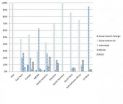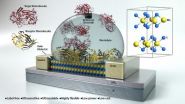(Press-News.org) Faced with climate change and diminishing opportunities to expand productive agricultural acreage, the world needs to invest in a global research agenda addressing farm and food systems, landscape and regional issues and institutional and policy matters if it is to meet the growing worldwide demand for food, fiber and fuel, suggests an international team of researchers.
In a paper appearing online in the journal Agriculture and Food Security, the authors summarize the findings of the second international Climate Smart Agriculture conference held in March 2013 at UC Davis.
"Climate-smart agriculture has become a global policy initiative for economic development, poverty reduction and food security," says lead author Kerri Steenwerth, a U.S. Department of Agriculture soil scientist and adjunct professor in the UC Davis Department of Viticulture and Enology.
"It makes sense for farmers, consumers and food businesses because it is focused on the long-term sustainability of supply chains, and applies both to farmers' fields and to the natural landscape," she said.
The objectives recommended in the new paper set the stage for a stronger emphasis on moving knowledge into action and involving researchers in helping communities and societies to change and adapt.
Steenwerth has posted a blog entry about the paper on the Biomed Central blog. The blog and the paper were supported by the UC Davis College of Agricultural and Environmental Sciences.
A third global science conference on Climate-Smart Agriculture is scheduled to be held March 16-18, 2015 in Montpellier, France.
INFORMATION:
The other authors on the paper from UC Davis were: Louise Jackson, Amanda Hodson, Arnold Bloom, Michael Carter, Jan Hopmans, William Horwath, Bryan Jenkins, Ermias Kebreab, Mark Lubell, Samuel Sandoval Solis, Michael Springborn, Stephen Wheeler, and Lovell Jarvis.
Authors representing other institutions were Andrea Cattaneo and Leslie Lipper, both of the Food and Agriculture Organization of the United Nations in Rome, Italy; Colin Chartres of the University of Canberra in Australia; Jerry Hatfield of the ARS/USDA National Laboratory for Agriculture and the Environment in Ames, Iowa; Kevin Henry of Colorado State University; Rik Leemans and Pablo Tittonell, both of Wageningen University, the Netherlands; Siwa Msangi of the International Food Policy Research Institute in Washington, D.C.; Ravi Prabhu of the World Agroforestry Center in Nairobi, Kenya; Matthew Reynolds of the Consultative Group on International Agricultural Research in Mexico; William Sischo of Washington State University; Sonja Vermeulen of the University of Copenhagen, Denmark; and Eva Wollenberg of the University of Vermont.
Media contacts:
Kerri Steenwerth, UC Davis Viticulture and Enology, 530-752-7535, ksteenwerth@ucdavis.edu
Louise Jackson, UC Davis Land, Air and Water Resources, 530-754-9116, lejackson@ucdavis.edu
Pat Bailey, UC Davis News and Media Relations, 530-752-9843
Climate-smart agriculture requires three-pronged global research agenda
2014-09-04
ELSE PRESS RELEASES FROM THIS DATE:
News media losing role as gatekeepers to new 'social mediators' on Twitter, study finds
2014-09-04
The U.S. government is doing a better job of communicating on Twitter with people in sensitive areas like the Middle East and North Africa without the participation of media organizations, according to a study co-authored by a University of Georgia researcher.
The study looked at the U.S. State Department's use of social media and identified key actors who drive its messages to audiences around the world. In particular, it examined the role played by news media and the government in bridging the State Department communication with people domestically and internationally. ...
Scientists identify rare stem cells that hold potential for infertility treatments
2014-09-04
DALLAS – Sept. 4, 2014 – Rare stem cells in testis that produce a biomarker protein called PAX7 help give rise to new sperm cells — and may hold a key to restoring fertility, research by scientists at UT Southwestern Medical Center suggests.
Researchers studying infertility in mouse models found that, unlike similar types of cells that develop into sperm, the stem cells that express PAX7 can survive treatment with toxic drugs and radiation. If the findings hold true in people, they eventually could lead to new strategies to restore or protect fertility in men undergoing ...
Sugar substitutes not so super sweet after all
2014-09-04
The taste of common sugar substitutes is often described as being much more intense than sugar, but participants in a recent study indicated that these non-nutritive sugar substitutes are no sweeter than the real thing, according to Penn State food scientists.
In the study, participants compared the taste of non-nutritive sweeteners that are often used as low- or no-calorie sugar substitutes with those of nutritive sweeteners, such as sugar, maple syrup and agave nectar. The participants indicated they could perceive the non-nutritive sweeteners -- such as aspartame, ...
UCSB researchers develop ultra sensitive biosensor from molybdenite semiconductor
2014-09-04
Move over, graphene. An atomically thin, two-dimensional, ultrasensitive semiconductor material for biosensing developed by researchers at UC Santa Barbara promises to push the boundaries of biosensing technology in many fields, from health care to environmental protection to forensic industries.
Based on molybdenum disulfide or molybdenite (MoS2), the biosensor material — used commonly as a dry lubricant — surpasses graphene's already high sensitivity, offers better scalability and lends itself to high-volume manufacturing. Results of the researchers' study have been ...
A minimally invasive, high-performance intervention for staging lung cancer
2014-09-04
Endoscopic biopsy of lymph nodes between the two lungs (mediastinum) is a sensitive and accurate technique that can replace mediastinal surgery for staging lung cancer in patients with potentially resectable tumours. Such were the conclusions of a prospective controlled trial conducted under Dr. Moishe Liberman, a researcher at the CHUM Research Centre (CRCHUM) and an Associate Professor at the Université de Montréal. Moreover, the study showed that it is not necessary to perform surgery to confirm negative results obtained through the endoscopic approach during the pre-operative ...
Breakthrough study identifies genetic link between the circadian clock and seasonal timing
2014-09-04
Researchers from the University of Leicester have for the first time provided experimental evidence for a genetic link between two major timing mechanisms, the circadian clock and the seasonal timer.
New research from the Tauber laboratory at the University of Leicester, which will be published in the academic journal PLOS Genetics on 4 September, has corroborated previous observations that flies developed under short days become significantly more cold-resistant compared with flies raised in long-days, suggesting that this response can be used to study seasonal photoperiodic ...
The yin and yang of overcoming cocaine addiction
2014-09-04
PITTSBURGH—Yaoying Ma says that biology, by nature, has a yin and a yang—a push and a pull.
Addiction, particularly relapse, she finds, is no exception.
Ma is a research associate in the lab of Yan Dong, assistant professor of neuroscience in the University of Pittsburgh's Kenneth P. Dietrich School of Arts and Sciences. She is the lead author of a paper published online today in the journal Neuron that posits that it may be possible to ramp up an intrinsic anti-addiction response as a means to fight cocaine relapse and keep the wolves of relapse at bay.
This paper ...
A metallic alloy that is tough and ductile at cryogenic temperatures
2014-09-04
A new concept in metallic alloy design – called "high-entropy alloys" - has yielded a multiple-element material that not only tests out as one of the toughest on record, but, unlike most materials, the toughness as well as the strength and ductility of this alloy actually improves at cryogenic temperatures. This multi-element alloy was synthesized and tested through a collaboration of researchers at the U.S. Department of Energy (DOE)'s Lawrence Berkeley and Oak Ridge National Laboratories (Berkeley Lab and ORNL).
"We examined CrMnFeCoNi, a high-entropy alloy that contains ...
Rosetta-Alice spectrograph obtains first far ultraviolet spectra of a cometary surface
2014-09-04
Boulder, Colo. — Sept. 4, 2014 — NASA's Alice ultraviolet (UV) spectrograph aboard the European Space Agency's Rosetta comet orbiter has delivered its first scientific discoveries. Rosetta, in orbit around comet 67P/Churyumov-Gerasimenko, is the first spacecraft to study a comet up close.
As Alice began mapping the comet's surface last month, it made the first far ultraviolet spectra of a cometary surface. From these data, the Alice team discovered that the comet is unusually dark at ultraviolet wavelengths and that the comet's surface — so far — shows no large water-ice ...
Avian influenza virus isolated in harbor seals poses a threat to humans
2014-09-04
(MEMPHIS, Tenn. – September 4, 2014) A study led by St. Jude Children's Research Hospital scientists found the avian influenza A H3N8 virus that killed harbor seals along the New England coast can spread through respiratory droplets and poses a threat to humans. The research appears in the current issue of the scientific journal Nature Communications.
The avian H3N8 virus was isolated by scientists investigating the 2011 deaths of more than 160 harbor seals. Researchers discovered the virus had naturally acquired mutations in a key protein that previous laboratory research ...




